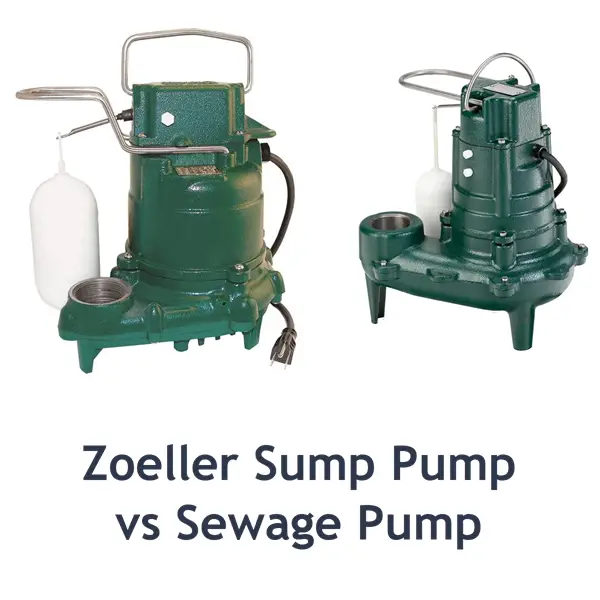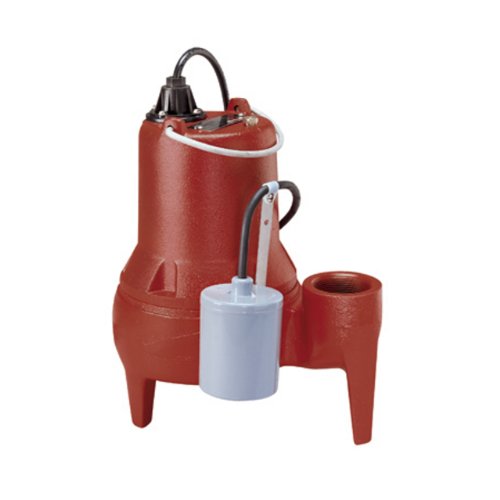Someone asking about a sump pump vs sewage pump purchase decision might not understand why two identical looking pumps are really different.
Sometimes this question comes up because their sewage pump has been working great for a long time but their sump pump doesn’t last as long.
Sometimes the sump pump vs sewage pump question is about price differences. Where a ½ HP sewage pump runs about $150-$500. Whereas a 1/2HP sump pump runs about $50-$300.
So, the question might be: If I am willing to buy a $300 sump pump why shouldn’t I buy a $300 sewage pump instead?
Or If I can buy a $50 sump pump why buy a $150 sewage pump? Can’t I just save the money?
The real answer depends upon which pump you are looking at and what you expect it to do. So, lets jump into the sump and look around.
Table of Contents
What Are the Main Sump Pump vs Sewage Pump Differences?
By definition a “sump” is a place where water or other fluids flow to and collect. So, that could be water or sewage.
For example, a homeowner might have a low spot in the yard where rainwater runs to a makes a large puddle. This is a common problem that is usually solved by a utility sump pump which you can get for about $50 or more.
Usually these are manually operated pumps, where they are plugged in to turn them on. Manually operated pumps are not suitable to be used as a basement sump pump or as a sewage pump.
In a machine shop, the sump is where the used cutting fluid is collected.
In a factory that makes orange juice from oranges, they would have a sump pump to move the juice through the factory and a sewage pump to move the orange pulp.
Many houses have a drain tile and sump pump system in the basement to keep the basement dry. These sump pumps can usually pump out 3/8-1/2 inch diameter round balls. Typically, the discharge pipe size is 1.5 inches. Although larger horsepower pump might need a 2-inch discharge pipe.
That same house might have a sewage pump system to remove the sewage from a basement toilet. These normally have a 2-inch discharge pipe. Supposedly, they can pass a 2-inch diameter object.
In reality, it would have to be something soft (sewage) that could be squished a bit to pass through the discharge pipe. Whereas, a hard solid 2-inch diameter ball will not pass through a 2-inch discharge pipe.
So, a sump pump is not able to pump out the larger sized solids that are in the sewage. The main reason is that the pump impellers are made differently in a sump pump vs sewage pump.

Can I Use a Sewage Pump as A Sump Pump?
Generally, that can be done, but it might not be the best choice. The answer depends upon where and why the sewage pump is being used.
It can be used as a replacement for a basement drain tile sump system pump. However, you will need a 2-inch discharge pipe instead of the standard 1.5-inch discharge pipe. That is OK if you need that much water flow per hour.
The 1/2 HP Zoeller 1096-0001 sump pump has a maximum flow rate of 80 gallons per hour.
Whereas, the Liberty Pumps LE51A sewage pump has a maximum flow rate of 160 gallons per hour.
However, the cost to operate a sump pump vs sewage pump is quite different. The amps used for a ½ HP sewage pump is about 15 amps whereas a sump pump will be about 9 amps. If the pump runs often that could be a substantial difference in electrical costs.
Since a sewage pump can move larger objects, it is somewhat akin to a trash pump. Which might make it a better choice for use outdoors in the yard where it might pass soft leaves and bits of sticks.
However, sewage pumps have feet that are about 3 inches tall. Which means that it will not pump any lower than that.
- 1-1/2-in NPT discharge passes 3/8-in solids.
- High efficiency, overload protected, oil-filled motor.
- 100% Factory tested. 3-year limited warranty. 9-ft. cord length.
- 1/2 HP Pro Cast Iron Sump Pump
- Pumps up to 160 GPM
- Shut-off head of 25-Foot
- Oil filled, thermally protected motor
- 2-vane semi-open impeller capable of passing a 2-Inch spherical solid
- Quick-disconnect 10-Foot standard power cord allows replacement of cord in seconds without breaking seals to motor
Sump Pump vs Sewage Pump Conclusions
Using a sewage pump in the place of a sump pump can be a good decision in certain circumstances. However, a sump pump cannot be used to replace a sewage pump.
In the sump pump vs sewage pump choice, the sewage pump has a couple potential benefits to consider.
First, a sewage pump of the same horsepower can pump twice the amount of water per hour versus the sump pump. That means you don’t have to buy a larger horsepower sump pump to pump the same amount of water.
If you want a compromise between a sump pump and a sewage pump, consider an effluent pump. It can be used as a sump pump in the basement drain tile system or in the septic tank that feeds the septic field.
- 1/2 HP pump for residential sump pits or septic tanks
- Automatic model with integral float switch, 1½” discharge, passes 1/2″ solids
- Performance: 72 GPM at 5′ head, shut-off: 23′ TDH
- All cast iron construction with stainless steel guard and handle
- 100% factory tested

Author at Best Sump Pumps
The first time I helped to install a drain tile and basement sump pump system was 1978.
Since then I have worked for a city water utility where I worked with and maintained pumps.
My rental properties and personal homes all needed sump pumps.
As a modular home dealer/builder, those new homes needed sump pumps.
I put that experience to good use by providing reliable, useful, and practical advice on buying, using, and maintaining sump pumps.




